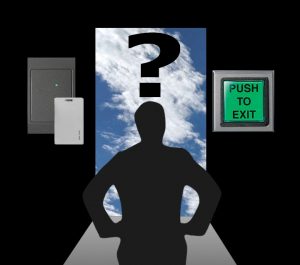Should You Consider Badge-Out?

We’ve been living in a COVID-19 world for more than five months now. As lockdowns have eased in some locations and businesses cautiously re-open, working from home remains encouraged because it reduces worker density inside office spaces. However, there are real benefits to returning to the workplace for some in-person meetings and other work activities. Video conferencing just cannot efficiently replace all meetings. Real face-to-face – even mask-to-mask – interaction with fellow employees is attractive, including the tangible benefits from brainstorming that happens when working together. There are good reasons we miss the old normal.
But it is true that the new work dynamic emerging from pandemic infection control is now more distributed. Our workforce is more portable and less scheduled. Workers who used to predictably badge in at 9 AM and leave the office at 5 PM are suddenly coming and going at more random times. A new typical workday might start as working from home in the morning, then entering the facility later in the morning for a more critical work-related task. Employees might break early to get something to eat and then head back to a different campus building to occupy a desk on a floor with lower occupancy density. They could then head home to close out their day’s tasks.
For building security staff, it’s suddenly more challenging to know precisely who is in the building at any given time. This makes it more challenging to account for all personnel quickly and accurately should there be an emergency evacuation. If this sounds like your organization, it may be time to consider adding employee badge-out as a standard procedure, especially if your current access control protocol only requires badging-in. This process change should gain employee acceptance quickly, along with countless other process changes necessitated for proper social distancing and masking. We are living in a time of heightened appreciation for personal security these days, whether directly health-related or otherwise.
Why is Badge-Out Important?

When your workforce arrives and leaves at roughly the same time, knowing who is in the facility is straightforward. If you cannot find someone during a fire drill, it might be easy to locate the person by asking the people who sit near their cubicle, office, or work area. But with fewer people working on-site, determining who is missing and who is working remotely suddenly requires a bit more guesswork.
Safety-critical or hazardous facilities, like refineries or chemical plants, often require badge-out or hard anti-passback to ensure an accurate accounting of personnel in the event of an emergency evacuation. In these facilities, monitoring real-time ingress/egress updates enables security personnel to quickly take an accurate tally of who was actually in the facility at the time of the evacuation. This means security personnel have fewer missing pieces to the emergency mustering puzzle during an evacuation. Security personnel can easily create a list of all badge holders who have badged into the facility in a matter of seconds; personnel who have badged out are eliminated. When a worker badges out upon leaving the facility, they are no longer a concern during the evacuation because they are filtered out of the roster. If these people are missing during a drill, it’s no big deal. However, in an emergency, knowing who has badged-in and needs to be accounted for, and who has badged-out and is no longer onsite is critical. Requiring badge-out means first responders will have a short, accurate list of people who may be in the building arrive when they arrive at the facility.
Without badge-out, there is no guarantee who has left your facility.
Can you track your true occupancy without badge-out? Sort of…
For installations with no confirming badge-out card scan, basic formulas can be applied to the emergency mustering process. For example, if an occupant badged in earlier that day, they might be considered possibly still in the building if they are not accounted for at the remote mustering location prior to normal closing times, say 5 PM. And obviously, if the system says an employee badged in a week ago but didn’t leave, you can be pretty sure they aren’t in the building.
A Real Life Situation

Personally, I’ve worked in a location that required badge-out. My company had about 100 employees working on three always-locked floors in a small multi-tenant office building in lower Manhattan. Some of us worked unconventional hours and many of us floated from floor to floor during the workday. Only the main floor had a receptionist who could let visitors in. Piggybacking was not permitted, nor was giving your badge to someone else. If you failed to badge out of one floor, you could not gain access to either of the other two floors. Employees needed to be manually let into the office space on the main reception floor to reset their in/out status. This assured us that only people with valid badges got into any area.
Badge-out also helped with overtime work audits. If the employee claimed on their timesheet to have worked until 7 PM, but their badge-out date/time stamp on that day showed 6 PM, this gave reasonable cause to investigate.
Having a badge-out requirement helped our security program greatly by reminding all of us on a daily basis of the physical security entry/exit procedure and process.
Beyond Badging-Out
Adding readers to to your existing access control system for employees to badge-out is a great first step to knowing who is in the building, and who is not, at all times. But to do it right, you want to make sure your existing access control system provides a good list of who is in your facility at all times. In many cases, you will find that your access control system is built mainly for just that – providing access to people, but it may not do a fabulous job tracking who is currently in your facility. From the start, XPressEntry was designed to keep track of who is currently in a facility, in order to account for personnel accurately in a fire drill, and minimize the time accounting for all employees. The XPressEntry system links to any access control system a company uses. As badges are presented to fixed readers at doorways and other access points, XPressEntry receives real-time updates of employee locations in the facility. These updates are instantly pushed out to XPressEntry handhelds. With XPressEntry, security personnel have fewer missing pieces to the emergency mustering puzzle during an evacuation — there’s no need to print a list of everyone in the facility because it’s available on any XPressEntry handheld device.
Had XPressEntry existed back at my old company in Manhattan, I’m sure our VP of Operations would have replaced the emergency mustering clipboard right away.
If you want to take badge-out to the next level, contact Telaeris at (858) 627-9700 to learn more about XPressEntry!

Leave A Comment